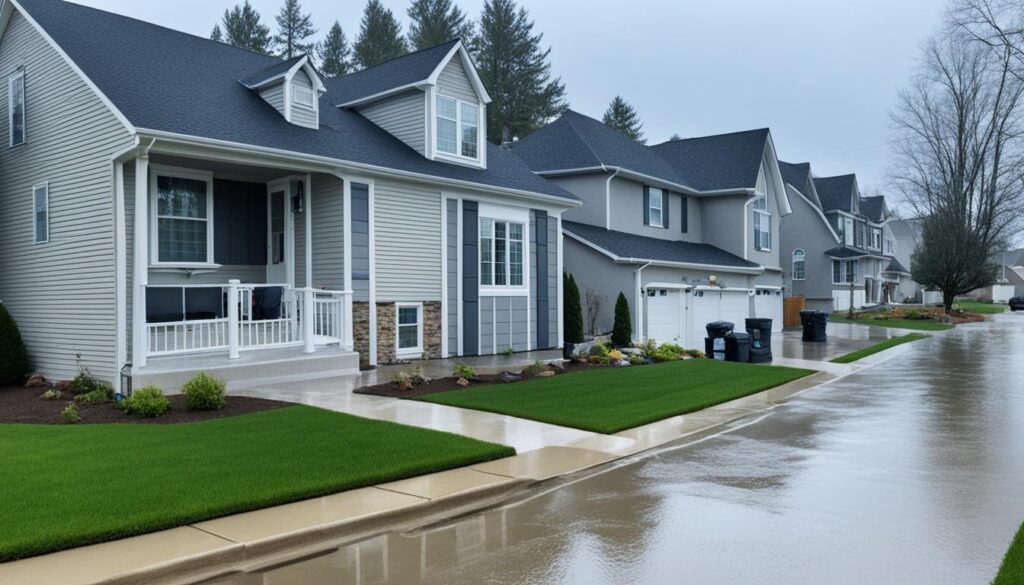Emergency Water Restoration Call- 619-775-3875
When it comes to natural disasters, few are as devastating as flooding. Each year, countless homes and properties are demolished by the relentless force of water, leaving families displaced and communities in ruin. While it may be impossible to completely prevent flooding from occurring, there are steps you can take to minimize the damage and keep your loved ones safe. In this article, we will share expert tips on how to prepare your house for flooding, giving you the peace of mind and the tools you need to face this formidable threat. From flood safety tips to a comprehensive flood readiness checklist, we’ve got you covered. By implementing these strategies, you will be better equipped to safeguard your home and navigate the challenges that come with a flood emergency. So, let’s dive in and learn how to fortify your house against the forces of nature.
Flooding is the top natural disaster in the U.S. It poses a huge risk to homeowners. By preparing your home well, you can keep your family and finances safe. Make sure to act when flooding is expected in your area. The first step is to buy flood insurance. Do not risk losing everything you’ve worked for.
Keep an eye on local news and weather to reduce flood impacts. Have a plan to stay in touch with everyone. It’s also vital to keep safe when flood warnings are up. You can find help to protect your home, utilities, and other buildings from floods.
Key Takeaways
- Flooding is the most frequent and damaging natural disaster in the U.S.
- Flood insurance is crucial to protect your home and belongings Emergency Water Restoration – 619-775-3875
- Monitor weather reports and have a communication plan in place
- Take steps to secure your home and family when flooding is imminent
- Resources are available to protect various types of residential properties
Understand the Risks of Flooding
Flooding is a common and dangerous disaster in the U.S., says FEMA. Flash flooding is particularly deadly. It can happen within six hours of a storm. Floodwaters might be dirty with sewage or debris. Just six inches of moving water can knock you down. One foot of moving water can carry your car away.
Identify If You Live in a Flood-Prone Area
Use FEMA’s flood map tool to see if you’re in a flood plain. It’s important to know your risk to protect your home and family.
Recognize the Dangers of Floodwaters
Floodwaters are dangerous and can make you sick. Check for water under your house or mold in your basement. If you find these signs, act fast to stay safe. Getting help from experts in flood or mold cleanup is a smart move.
Get Flood Insurance
Regular homeowner’s insurance doesn’t include flood damage. So, it’s wise to buy flood insurance, especially if you live in a flood area. Just an inch of floodwater can cause up to $25,000 in home damage. Also, there’s usually a 30-day wait after buying your policy before it starts working.
Don’t wait for the flood to happen – get insured now. This way, your home and belongings are safe from costly repairs.
The NFIP has over 5 million policyholders and gives out about $1.3 trillion in coverage for flood damage. It works in over 23,000 areas. There’s also the WYO program that includes over 50 insurance companies with different flood coverage options.
Remember, flood insurance starts working after 30 days. So, don’t wait until a storm is about to hit. Protect your home and finances by buying flood insurance right away.
Also Read: How To Absorb Water In Basement
Create an Emergency Preparedness Plan
Having a solid emergency preparedness plan at home is key, especially if flooding is a risk. First, check FEMA’s Flood Map Service Center. This helps you see if your home is in a flood-prone area. Knowing this will let you focus on preparing for the particular risks you face.
Establish Communication and Evacuation Plans
Set up a communication plan for flood warnings and how to get help from local officials. Pick out evacuation shelters nearby and plan how to get there safely if it floods. Make sure everyone knows their part in these plans.
Assemble an Emergency Kit
Make a full emergency kit with all the supplies your family will need for a few days. Include a hand-crank radio, flashlight, first aid kit, medicine, and enough easy-to-store food and water. Don’t forget cleaning supplies for water damage cleanup and mold removal after the flood.
How To Prepare Your House For Flooding
Elevate Critical Home Systems
If you live in a flood-prone area, raising your home’s vital systems can save you a lot. Raise things like your furnace, water heater, and electrical panel at least 12 inches higher than the flood’s base level. This simple step helps keep them safe from flood damage, lowering repair costs.
Seal Potential Entry Points
Look for any spaces where water might sneak in and seal them. Use good caulk or sealant. Doors, windows, and the foundation are key places to check. Making these areas watertight fights off flooding.
Clean Gutters and Ensure Proper Drainage
Keeping gutters and downspouts clean is vital. They help water move away from your home. Add a sump pump with a battery backup for extra protection. Good drainage is crucial in avoiding a wet home when it rains hard.
Stock Up on Essential Supplies
When it comes to preparing your home for flooding, the right emergency materials are key. FEMA tells homeowners in high flood risk zones to keep things like plywood, lumber, and sandbags. These supplies help seal off your home, secure items outside, and fix things after the water goes down.
Gather Emergency Building Materials
Along with the basics, FEMA suggests having a pry bar, shovels, a saw, and a hammer. These tools are vital for cleaning up and repairing after a flood. Also, using permeable pavement helps water go into the ground, stopping puddles on the surface.
Having these emergency building materials at hand can save time and effort. By getting these supplies ready ahead of time, you can protect your home better and lessen flood damage.
Stay Informed About Flood Watches and Warnings
Staying safe during a flood is all about knowing the latest flood watches and flood warnings. You’ll get these crucial weather alerts and emergency notifications in several ways. This includes the Emergency Alert System (EAS), the NOAA Weather Radio, and local emergency channels.
Don’t forget to install the FEMA app. It gives you up-to-the-minute information on weather and flood dangers. Watching the news and weather updates, and signing up for alerts, keeps you ready for any flooding.
| Flood Preparedness Essentials | Flood Damage Statistics |
|---|---|
|
|
Being alert and prepared is key for your home and family during flood watches or flood warnings. Taking action ahead of time can reduce flooding’s impact. It helps keep you and your family safe when severe weather strikes.

Take Action When Flooding Is Imminent
If told to leave, do so right away. Floodwaters rise fast. If leaving isn’t an option, secure your home and things. Put light outdoor items indoors. This includes patio furniture, plants, and toys, since they can cause harm if carried by water.
Turn off utilities at main switches and valves, and disconnect appliances if you can. Move essential items to higher levels to reduce damage risk.
Secure Outdoor Items
It’s critical to move light outdoor items like patio furniture and toys indoors. They could be carried off and harm property in a flood.
Turn Off Utilities
Turning off utilities at main points shields your home’s systems. Also, disconnect appliances to avoid electrical dangers.
Move Essential Items to Higher Levels
Move essential items to a higher floor if you can’t evacuate. This keeps them safe from floodwater. Don’t forget important papers, valuables, and necessary items. By raising these things, you lower the risk of water harm.
Evacuate If Instructed
During a flood, following orders to leave can save your life. Floodwaters can rise quickly. You may be asked to leave home at a moment’s notice. Remember, your safety comes first. Your belongings can be replaced, but you can’t. So, focus on finding a safe place.
When the flood is over and authorities say it’s safe, that’s when you go back. But, don’t rush in. Check your house for damage and gas leaks first. Taking these steps could keep you from harm.

Listening to flood evacuation advice and being prepared are key. They protect you and your loved ones. By getting ready for emergencies, you’ll lessen flood’s terrible effects.
Exercise Caution When Returning Home
After a flood, always be careful when going back to your house. First, check if your home is still safe to enter. Look for any damage or things that could be dangerous.
Check for Structural Damage
Look closely at the base, walls, and roof of your home. Check for cracks or changes that could be from the flood. If you see anything wrong, don’t go in until an expert says it’s safe. The flood may have made your home less stable. Safety comes first when you’re returning home after a flood.
Beware of Electrocution Risks
Watch out for the electrocution risks of flood damage inside your house. The water could have messed up wires or tools, which is very dangerous. Don’t touch them until an electrician has checked them.
Always prioritize safety when returning home after a flood. Take steps to keep yourself and your family safe. Also, remember it might take time to get everything back to normal.
Conclusion
It’s essential to get your home ready for flooding to keep it, your things, and your loved ones safe. Doing things like buying flood insurance, making a plan, and securing your home can lower the flood’s effect. Always stay updated, act fast when a flood is on the way, and be careful coming back home. With the correct steps, you can protect your house and increase your chances of surviving a flood.
No matter where you live, knowing the flood risks and how to shield your home is key. There are services to help with flood repairs and great advice available. Being ready and alert lets you protect your family and your home.
Staying prepared for floods is an ongoing effort. But, with the right approach, you can combat any flood. Focus on preventing floods and protecting your home to worry less. Always remember, staying informed, ready to act, and prepared for surprises is crucial for good flood preparation.
FAQ
How can I identify if I live in a flood-prone area?
What are the dangers of floodwaters?
Why do I need to purchase flood insurance?
What should I include in my emergency preparedness plan?
How How To Prepare Your House For Flooding?
What supplies should I have on hand for a flood emergency?
How will I be alerted to flood watches and warnings?
What should I do if I’m told to evacuate?
What should I do when returning home after a flood?
Source Links
- https://www.familyhandyman.com/article/how-to-prepare-for-a-flood/
- https://www.ready.gov/floods
- https://www.directenergy.com/en/learn/weather-center/prepare-home-flood
- https://www.fema.gov/sites/default/files/documents/fema_protect-your-home-from-flooding-brochure_2020.pdf
- https://www.bankrate.com/insurance/homeowners-insurance/how-to-prevent-home-from-flooding/
- https://www.fema.gov/flood-insurance
- https://www.redcross.org/get-help/how-to-prepare-for-emergencies/types-of-emergencies/flood.html
- https://www.stormguardrc.com/resources/how-homeowners-should-prepare-for-a-flood/
- https://recovery.texas.gov/preparedness/flood-preparedness/index.html
- https://www.ready.gov/kit
- https://www.nyc.gov/site/em/ready/flooding.page
- https://www.ci.patterson.ca.us/488/What-To-Do-Before-During-and-After-a-Flo
- https://www.psafinancial.com/2023/07/dont-let-flash-flood-take-you-by-surprise-tips-to-be-prepared/
- https://www.jbmdl.jb.mil/Portals/47/documents/AFD-150205-020.pdf
- https://pinellas.gov/safety-tips-before-during-and-after-a-flood/

